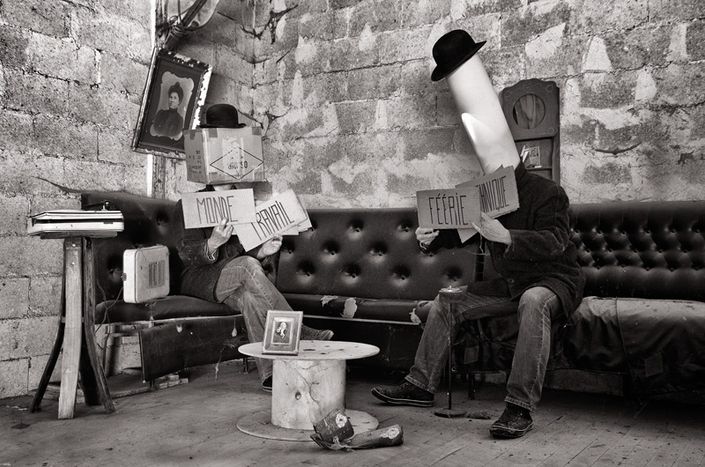
No EOTG without a debate!
Published on
Which urban policy for which society? It has become a tradition that an EOTG must end with a debate. Despite its defiant tendencies, La Parisienne has followed the usage in force within the Babelian community. As a result, a coffeehouse debate on “Which urban policy for which society?” has been organized with all the professionalism defining La Parisienne.
In the end, two hours of impassioned discussions which went so fast.
 The housing problem has been the guiding thread of this EOTG’s edition and based on this, the debate gathered top-notch contributors: Pierre Mansat, Deputy Mayor in Paris in charge of the relations with local authorities in region Ile de France ; Mourad Cheurf, head consultant of Mconseil, a counseling agency specialised in urban policy, Fernando Navarro, Spanish journalist and editor for Babel international.
The housing problem has been the guiding thread of this EOTG’s edition and based on this, the debate gathered top-notch contributors: Pierre Mansat, Deputy Mayor in Paris in charge of the relations with local authorities in region Ile de France ; Mourad Cheurf, head consultant of Mconseil, a counseling agency specialised in urban policy, Fernando Navarro, Spanish journalist and editor for Babel international.
On the other side, a good quality audience: a lot of Parisians plus some Europeans.
Led by Ruth Bender who organised this EOTG and editor for Cafebabel.com and Jean Sébastien Lefèbvre, general secretary of La Parisienne and brilliant journalist, the debate primarily focused on Paris and the issue of the gap between the capital and its outskirts.
Social cleavage, as well as structural and economical with a transportation network whose good organisation fails beyond the first ring and obsolete housing structures.
Pierre Mansat immediately pointed out this shameful duality between Paris and its surroundings, even though he reminded the gaps existing within the suburbs themselves where ghetto systems are unfortunately being established. For him Paris is symptomatic of the tendency to disjunction in the European main cities. Paris is just a striking example of this geographical and social disintegration going through our modern societies. Other European big cities suffer from this regnant disease that is the lack of solidarity.
On the contrary, for Mourad Cheurf, the dilemma between Center/Periphery is not the best explanation to this topical cleavage. Communitarianism must not be simply stigmatized as a reactionary attitude against public order but it would rather be interpreted as a sign of unadapted urban policies to the urban, cultural and social realities of these past years.
According to him, “what must be placed at the very centre of any urban policy is the person as a human being” and initiatives that will enable a “living-together” must be taken. The public authorities should shape their action following the American example and thus coordinate it with private counselling agencies whose experience on the field would be highly valuable.
Fernando Navarro, hellion in this debate, pointed out that France, contrary to Spain, has kept on revelling in great speeches on social malaise and the necessity to bridge people without taking any concrete measures. As an effective factor of exchange and ground for encounters between inhabitants, sport should be taken into account in urban policies. There are stadiums in Paris and around but for professional games and training only.
Why don’t we open these stadiums to the citizens since sport bring them together? A question the two other participants did not answer.
Fernando mentioned another problem: the concentration of commercial and residential districts which contributes to isolate the areas where wealth is produced and those who can directly profit from it.
For Mourad Cheurf, one single motto: “stop this passive compliance” it is time to “take control”.
An audience very interested in the exchange of views
In answer to this statement, Kathrina from Germany (ex-East Germany) in the audience, brings up some nuances. A popular initiative is advisable to put an end to this crisis, but it will not be enough. Taking Berlin as an example, she indicates that German cities are way more socially mixed since Germany, contrary to France, does not exile the disadvantaged communities in the projects but try to mingle this people with the rest of the population. Segregation seems thus for her less obvious than in Paris even though territorial determinism remains substantial.
Kathrina added that urban policies should take the problem the other way around; that is re-introduce social and cultural diversity within the urban centers in order to bring a beginning of peace into these areas and re-establish a territorial continuity.
Resolute Italian, Adriano digs far deeper to find causes to this French malaise. For him, acts of violence are everywhere in Europe, and more than ever in Italy – especially during football games – but the French case is different due to its tradition of cultural repression. Far from a stalinist critic observation, the movements of disapprobation in their most extreme manifestations that have been observed this past three years find grounds in the lack of regard to cultural diversity.
Questioned about the situation in their respective countries, Katri and Natalia gave a European touch to a very Paris-centred debate.
In Estonia, the problem takes a different aspect because of the clear and claimed ethnic separation between Russians and Estonians. Taken for granted, this situation results from a historical legacy and founds the different political trends; today it has then no workable solution!
In Poland, the problem is again different. There is no ministry dedicated to the definition of urban policies in this country where a zone-system divides the projects. The increase of crime observed after the collapse of the Soviet Union led to the reunion of the zones identified by the population as risky.
The Europe on the Ground showed us that there are no single solution to a single problem but a variety of historical, geographical, social and political factors to which the urban policy alone cannot give any miracle answer.



